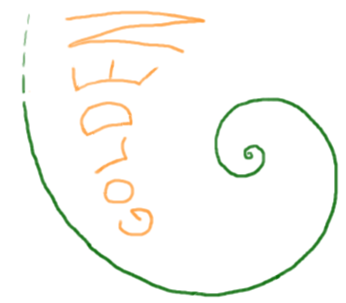Form and content – two levels of change
« Previous Page | 1 2 3 4 5 6 7 8 9 | View All | Next Page »
Fibonacci, Content, and Form
The well-known Fibonacci sequence $latex (0,1,1,2,3,5,8\dots)&s=-1$ is produced by an iterated (recursive) equation that describes a fundamental property of a vast array of natural forms, from the construction of your own body to sunflowers, to galaxies. Or perhaps you’ve heard of the Mandelbrot set, an almost infinitely complex fractal form created by iterating and then graphing the complex recursive equation $latex z_{n+1} = z_n^2 + c&s=-1$.
As indicated above, it is important to distinguish between the content and the Form when thinking about change, and the Fibonacci sequence provides an excellent demonstration of why this is so. The content of the Fibonacci sequence $latex (0,1,1,2,3,5,8\dots)&s=-1$ is a series of numbers produced by the equation $latex F_n = F_{n-1} + F_{n-2}&s=-1$. The equation provides the Form by which the content is produced; the only thing that needs to be “given” from outside the system are the first two numbers (0 and 1) to get the equation going, and then the rest of the infinite sequence flows out naturally. This may seem all well and good, but something amazing is happening here, just below the surface, and understanding it will help you get a sense for the profound difference between the level of content and the level of Form.
If you take any two adjacent numbers in the Fibonacci sequence and divide the second number by the first number, you will get what is known as a ratio, a new number that encapsulates a particular kind of difference between two quantities. What is amazing about the Fibonacci sequence is that if you take the ratio between any two successive numbers in the sequence, you will find that the ratio tends towards a very specific number: $latex 0.6180339887\dots&s=-1$ . This number, which has an infinite amount of non-repeating numbers after the decimal point, is known as the phi ratio or the golden ratio, and it is a number that is behind the creation of countless forms in nature. The golden ration is a second order process, a Form, that acts as a context through which an infinite number of lower order forms can be generated. It is a pattern that connects those forms.
But the important part for our consideration is the following: it doesn’t matter what initial numbers you start with. You can take any two numbers (including complex numbers involving i) as the first two numbers of the recursion; they all tend towards the golden ratio. This is a perfect example of the difference between content and Form. On the one hand, the content has an independence from the Form, as no matter what numbers you start with, placing them in the context of the Fibonacci relation tends toward the golden ratio (the golden ratio is technically the “limit” of the process). On the other hand, the content is quite directly dependent upon the Form, as each successive iteration is determined it.
This polarity reveals a very important principle that makes a big difference when thinking about change: where exactly you begin matters less than how you proceed. The emphasis here is on the how: the Form, the context, the pattern, the second order relations.
« Previous Page | 1 2 3 4 5 6 7 8 9 | View All | Next Page »






Firstly, my sympathies.Secondly, maybe a lttile hope. As you know I plunged in to this world of “EdTech” rather late – and it’s been my observation that most of the people writing about EdTech are no longer writing about EdTech at all. The interesting ones are writing about culture, society and life. EdTech is just an increasingly bare frame to hang more interesting ideas on. The interesting folks add insight, the duller ones platitudes and clunking rhetoric but the framework is no longer important. With your brain and your cross-disciplinary magpie-ism you could find a home in any academic discipline. Of that I am sure.